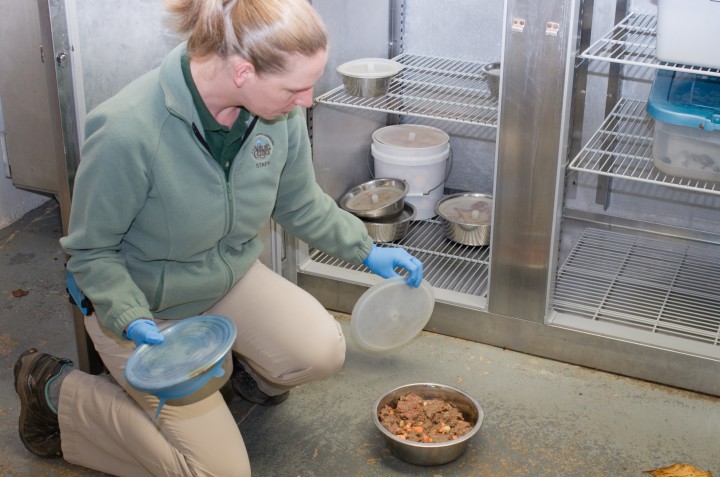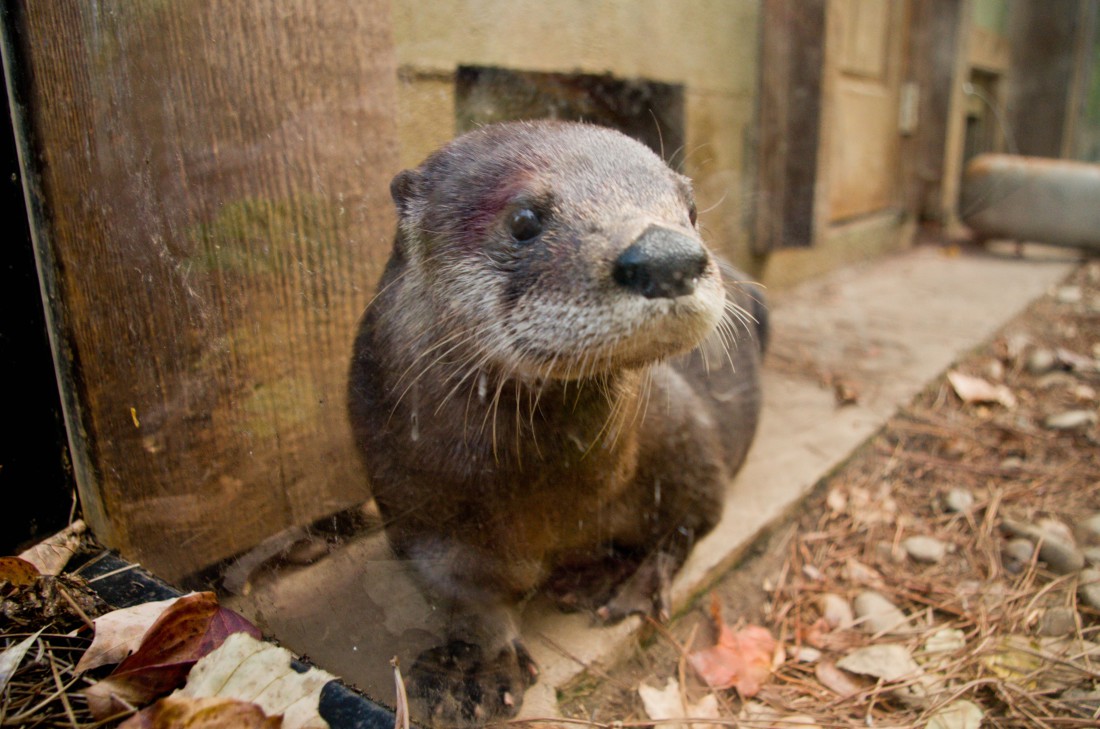To feed your household dog, cat — or pig, for that matter — takes nothing more than a trip to PetSmart. Meeting the dietary needs of wild animals, however, requires a little more effort than cracking open a can.
At the WNC Nature Center, about 250 animals live on-site, representing 60 species. None of the residents can be released back into the wild, so the 42-acre property is their permanent home.
As any team member will tell you, such a diverse population requires a well- and weirdly stocked kitchen. Nibbles the groundhog’s leafy foodstuffs, for instance, are a far cry from the carnivorous cougars’ morning eats.
So what is on the menu for these diverse residents? And how does a group of humans make sure these wild critters are getting the nutrition they need?
Chris Gentile, executive director of the Nature Center, says that the animals’ diets are among the most important aspects of operation, and his team is highly trained in food preparation, nutrition and procedure.
“Preparing food is something that’s a learned trade. When we bring an animal care person in, they spend a lot of time watching and learning from people who really know,” he explains. Each animal is different, and each eats a diet specifically tailored to its needs.
Take the otters, for example. Obi Wan and Olive are among the center’s most popular attractions.
“When we get surveys and Trip Advisor comments, otters are always the most-mentioned animal,” says Gentile. As far as their daily menu goes, they eat fish — just as they would in the wild, he says.

“The fish come from a local stock area,” he explains — the same type of farm that raises fish for restaurants. “We get a delivery a few times a year, freeze it, then take the fish out as we need it so it defrosts in the fridge. We cut it up into small bits — we don’t feed them whole fish or live fish.”
Sometimes, the otters get fish Popsicles: giant ice cubes with fish bits frozen inside. As they melt, the otters get their snacks and a little bit of entertainment too.
“It’s not like humans where they just cut off a filet,” explains Gentile. “They eat bones, eyes, the head — it gives them calcium and nutrients from other parts of the fish.
The public always has a chance to watch the feeding ritual — the critters dine about 11:30 a.m. daily at Otter Falls, says Gentile.
People are also curious about the diets of the Nature Center’s two cougars, Pisgah and Mitchell (named for two of Western North Carolina’s most famous peaks), says Gentile. As carnivores, their diet is all meat.
“Most people don’t realize that carnivores in zoos — here, at the North Carolina Zoo or any other zoo people might have visited in the area — most of the time the carnivores are getting commercially prepared meat. We don’t feed them deer we find in the road,” explains Gentile.
Their food is produced by a commercial meat manufacturer — much like dog food, only specially formulated to include all the nutrients the cougars need. The center orders from a company out of Nebraska, and they have a nutritionist on staff.
“They provide it in what looks like a 5-pound log of sausage — a five-pound ration,” explains Gentile. “We get two or three deliveries a year, and as we go, we’ll pull out what we need, let it defrost and prepare it that way.”
It’s crucial that the team knows exactly what’s in the food, says Gentile. “Say we don’t know that there’s a certain mineral in a meat, then an animal gets sick — our vet would have to uncover that stone. Knowing what goes into an animal’s diet is like preventative medicine,” he explains.
While the commercially prepared recipe makes up the bulk of the cougars’ diets, occasionally they get a little something extra, says Gentile. “Local hunters may donate part of a deer, like a leg, and the cougars and other carnivores will chew on that and get their calcium. It’s not a common thing — we only do it when it’s available.”
The snakes also have a unique dietary regime. “Rattlesnakes eat a whole rat or a whole mouse and digest it, just like they would if they caught a mouse or rat in the wild,” Gentile says.
The center sources mice and rats from a company that produces feeder animals for different zoos. The sizes of the rodents depend on the sizes of the snakes. “A bigger snake will eat a larger rat, while a corn snake will eat a much smaller rat or a large mouse,” says Gentile. Like the other animals’ food, the mice and rats are frozen then defrosted for consumption.
Clearly, one size does not fit all when it comes to the center’s hundreds of inhabitants and their daily diets. Hippocrates’ words about food being medicine apply to wild animals too. Hence the need for a well-stocked fridge. And freezer.
“Think of all the things that need to be in our grocery store,” adds Gentile. “We have animals that eat hay, we have mealworms, crickets, not to mention dry food we feed the bears that comes in a dog food-type bag. We have a lot of different items in our grocery store — more than you’d ever find at Ingles.”



Before you comment
The comments section is here to provide a platform for civil dialogue on the issues we face together as a local community. Xpress is committed to offering this platform for all voices, but when the tone of the discussion gets nasty or strays off topic, we believe many people choose not to participate. Xpress editors are determined to moderate comments to ensure a constructive interchange is maintained. All comments judged not to be in keeping with the spirit of civil discourse will be removed and repeat violators will be banned. See here for our terms of service. Thank you for being part of this effort to promote respectful discussion.